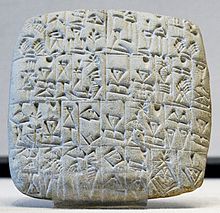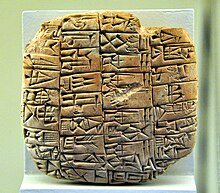Shuruppak
 | |
| Alternative name | Tell Fara |
|---|---|
| Location | Al-Qādisiyyah Governorate, Iraq |
| Region | Sumer |
| Coordinates | 31°46′39″N 45°30′35″E / 31.77750°N 45.50972°E |
| Type | archaeological site, human settlement |
| Area | 120 hectare |
| Height | 9 metre |
| History | |
| Periods | Jemdet Nasr period, Early Dynastic period, Akkad period, Ur III period |
| Site notes | |
| Excavation dates | 1902; 1931 |
| Archaeologists | Robert Koldewey, Friedrich Delitzsch, Erich Schmidt, Harriet P. Martin |
Shuruppak (Sumerian: 𒋢𒆳𒊒𒆠 ŠuruppagKI, "the healing place"), modern Tell Fara, was an ancient Sumerian city situated about 55 kilometres (35 mi) south of Nippur on the banks of the Euphrates in Iraq's Al-Qādisiyyah Governorate. Shuruppak was dedicated to Ninlil, also called Sud, the goddess of grain and the air.[1]
Shuruppak and its environment
Shuruppak is located in Al-Qādisiyyah Governorate, approximately 55 kilometres (35 mi) south of Nippur. The site of extends about a kilometer from north to south. The total area is about 120 hectares, with about 35 hectares of the mound being more than 3 meters above the surrounding plain, with a maximum of 9 meters.
History of research


After a brief survey by Hermann Volrath Hilprecht in 1900, it was first excavated in 1902 by Robert Koldewey and Friedrich Delitzsch of the German Oriental Society for eight months.[2] Among other finds, hundreds of Early Dynastic tablets were collected, which ended up in the Berlin Museum and the Istanbul Museum. In March and April 1931, a joint team of the American Schools of Oriental Research and the University of Pennsylvania excavated Shuruppak for a further six week season, with Erich Schmidt as director and with epigraphist Samuel Noah Kramer.[3][4] The excavation recovered 87 tablets and fragments—mostly from pre-Sargonic times—biconvex, and unbaked. In 1973, a three-day surface survey of the site was conducted by Harriet P. Martin. Consisting mainly of pottery shard collection, the survey confirmed that Shuruppak dates at least as early as the Jemdet Nasr period, expanded greatly in the Early Dynastic period, and was also an element of the Akkadian Empire and the Third Dynasty of Ur.[5]
Occupation history

Shuruppak became a grain storage and distribution city and had more silos than any other Sumerian city. The earliest excavated levels at Shuruppak date to the Jemdet Nasr period about 3000 BC; it was abandoned shortly after 2000 BC. Erich Schmidt found one Isin-Larsa cylinder seal and several pottery plaques which may date to early in the second millennium BC.[6] Surface finds are predominantly Early Dynastic.[7]
The report of the 1930s excavation mentions a layer of flood deposits at the end of the Jemdet Nasr period at Shuruppak.[3] More recently, it has been suggested that the nature of this deposit is more like that deposited by river avulsions, a process that was very common in the Tigris–Euphrates river system.[8]
Metalwork
Several objects made of arsenical copper were found in Shuruppak/Fara dating from the mid-fourth to early third millennium BC (approximately Jamdat Nasr period), which is quite early for Mesopotamia. Similar objects were also found at Tepe Gawra (levels XII-VIII).[9]
The city expanded to its greatest extent at the end of the Early Dynastic III period (2600 BC to 2350 BC) when it covered about 100 hectares. At this stage it was destroyed by a fire which baked the clay tablets and mudbrick walls, which then survived for millennia.[10]
Two possible kings of Shuruppak are mentioned in epigraphic data from later sources found elsewhere. In some versions of the Sumerian King List a king Ubara-Tutu is listed as the ruler of Shuruppak and the last king "before the flood". In the Epic of Gilgamesh, a man named Utanapishtim (also Uta-na'ishtim), son of Ubara-Tutu, is noted to be king of Shuruppak. The names Ziusudra and Atrahasis are also associated with him. These figures have not been supported by archaeological finds and may well be mythical.
See also
Notes
- ^ Jacobsen, Thorkild (1 January 1987). The Harps that Once--: Sumerian Poetry in Translation. Yale University Press. ISBN 978-0-300-07278-5.
- ^ Heinrich, Ernst; Andrae, Walter, eds. (1931). Fara, Ergebnisse der Ausgrabungen der Deutschen Orient-Gesellschaft in Fara und Abu Hatab. Berlin: Staatliche Museen zu Berlin.
- ^ a b Schmidt, Erich (1931). "Excavations at Fara, 1931". University of Pennsylvania's Museum Journal. 2: 193–217.
- ^ Kramer, Samuel N. (1932). "New Tablets from Fara". Journal of the American Oriental Society. 52 (2): 110–132. doi:10.2307/593166. JSTOR 593166.
- ^ Martin, Harriet P. (1983). "Settlement Patterns at Shuruppak". Iraq. 45 (1): 24–31. doi:10.2307/4200173. JSTOR 4200173.
- ^ Martin, Harriet P. (1988). FARA: A reconstruction of the Ancient Mesopotamian City of Shuruppak. Birmingham, UK: Chris Martin & Assoc. p. 44, p. 117 and seal no. 579. ISBN 0-907695-02-7.
- ^ Adams, Robert McC. (1981). Heartland of Cities. Chicago: University of Chicago Press. Fig. 33 compared with Fig. 21. ISBN 0-226-00544-5.
- ^ Morozova, Galina S. (2005). "A review of Holocene avulsions of the Tigris and Euphrates rivers and possible effects on the evolution of civilizations in lower Mesopotamia". Geoarchaeology. 20 (4): 401–423. doi:10.1002/gea.20057. ISSN 0883-6353.
- ^ Daniel T. Potts, Mesopotamian Civilization: The Material Foundations. Cornell University Press, 1997 ISBN 0801433398 p167
- ^ Leick, Gwendolyn (2002). Mesopotamia: The Invention of the City. London: Penguin. ISBN 0-14-026574-0.
References
- Pomponio, Francesco; Visicato, Giuseppe; Westenholz, Aage; Martin, Harriet P. (2001). The Fara Tablets in the University of Pennsylvania Museum of Archaeology and Anthropology. CDL Press. ISBN 1-883053-66-8.
- Matthews, R. J. (1991). "Fragments of Officialdom from Fara". Iraq. 53: 1–15. doi:10.2307/4200331. JSTOR 4200331.


